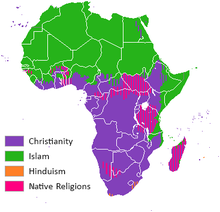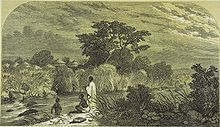Religion in africa
Religion in Africa is an integral part of cultural life on the continent. Religion in Africa encompasses almost all areas of life and plays a central role for people. The vast majority of Africans belong to Christianity and Islam , with Islam tending to predominate in the northern countries of the continent, in West Africa and on the coasts of East Africa, while Christianity is more prevalent in the center of the continent and in the southern countries. Because of the uncertainty of the statistical data available, it is unclear which of the two religions in Africa currently has more followers.
In addition to these two religions, a large number of traditional religions in various forms have survived in Africa. The traditional religions have also combined with Christianity and Islam to form mixed forms, so-called syncretism . Some communities were formerly assigned to Judaism , but have long since been dissolved as a result of the Middle East conflict or other regional conflicts (e.g. in Ethiopia) and emigrated mainly to Israel. Many African religions have certain things in common. Yet there is no universal aspect that is common to all African religions.
Christianity

Main article: Christianity in Africa
The first historical evidence of a Christian presence in sub-Saharan Africa comes from Ethiopia in the 4th century . The Christian mission in Africa has spread Christianity on the continent strongly since the Middle Ages, but especially during the colonial period, together with evangelization , including through Pentecostal movements in the 20th century.
Despite persecution during the Roman Empire, Christianity spread throughout the north of the continent . Around the time when Christianity became the state religion in Rome, it also achieved the status of an official religion in Ethiopia . With the triumphant advance of Islam in North Africa from the 7th century, the further spread of the Christian religion in Africa temporarily ended. Of the originally Christianized areas, only Egypt remained , with the Coptic Church , the three Nubian empires in today's Sudan (up to the 14th / 15th centuries) and parts of today's Ethiopia.
The religion was also used to promote colonization .
It was not until the 15th century that Christianity reached the areas south of the Sahara. It was brought to the continent by sea by the European colonial powers, first by the Portuguese. They achieved certain proselytizing successes in the vicinity of their trading bases, but also with individual African rulers, e. B. Afonso I , the ruler of the Congo Empire, who operated the Christianization of his powerful empire at the beginning of the 16th century. In the 19th century, Protestant missionaries began systematic conversion work in Africa.
The Bible has been translated into various African languages over the past 200 years to facilitate missionary work. A portion of Christianity belongs to independent African churches , the size of which cannot be defined due to the diversity of these churches. More recent is the sometimes fatal influence of mostly radical North American evangelicals in Africa, for example in Nigeria or Uganda .
Islam
Together with Christianity, Islam is one of the most widespread religions in Africa . It reached Africa soon after the death of the founder of the religion and prophet Mohammed and spread mainly in the north of the continent. This religion also found its followers in a narrow band along the east coast. Islam had already arrived in some settlements on the East African coast in the 8th century, along with Arab merchants who traded by sea.
Via the trade routes, Islam also spread to desert areas and steadily further south. With the exception of the subjugation of the Ghana Empire , the expansion of Islam south of the Sahara was largely peaceful. Most of the armed conflicts over the spread of Islamic teaching have been between different Islamic faiths. The spread of Islam was largely determined not only by trade interests, but also by the interest of local rulers in the scholarly knowledge of Arab traders. Around 1880, Islam was the dominant religion in the northern third of the continent. Most of West Africa is now also predominantly Muslim.
Since the Koran was only available in Arabic, Muslim missionaries were on hand as mediators, and later Koran schools were established. The colonial powers, especially the British, initially left the education to the Islamic teachers without bothering about the religious content. During the time of the European colonial powers, Islam was no longer ousted from northern Africa.
African religions
All beliefs that arose before the spread of Islam and Christianity or independently of them and are still alive today are generally referred to as African religions .
These African religions represent the third largest group of religions in Africa. In the course of history, Christianity, Islam and African currents influenced and mixed each other. Today it is no longer possible to separate what was originally African and what was influenced by Western concepts. Many religious structures in the West were incorporated into existing systems of thought or they were differentiated from them.
Various characteristics have been assigned to the traditional religions, but these must by no means be generalized, as they are based on Western concepts and ways of thinking. Some traditional religions share belief in a higher being and several lesser deities. Supreme God is not directly worshiped as he is considered too holy to listen to people's wishes and prayers. Therefore, people use the lower gods as transmitters to the highest god. Sometimes these gods have a totem . Animals are revered as earthly representatives of certain gods. Each subordinate God is responsible for a certain area in the life of the believer and exercises his power there. Although a god rules over the subordinate gods or demigods, this supreme god exists in a relative detachment from everyday life. The animism takes nature as the spirit of true met. Animal sacrifices are common to ensure the protection and grace of the godhead. They should also satisfy or appease the spirits and forces of nature. Traditional beliefs often include rites for the introduction of a child into the community, the transition from childhood to the role of an adult during so-called initiation rites, and the transition of a person into the realm of the ancestors after death. In traditional religions, places, things or living beings are considered sacred. The respect for the ancestors is often reflected in an ancestral cult .
Healing powers of people, the belief in good and bad spirits as well as in magic and magic power are also part of the traditional religions. Also the fetish is not infrequently for the believers as the dwelling place of a lower god and thus as an aid of their religion.
See also: African cosmogony
Syncretism
Syncretism , i.e. the mixing of religions, occurs in Africa between Christianity and traditional religions as well as Islam and traditional religions.
The Lord's Resistance Army of Acholiland in northern Uganda, for example, combines the Roman Catholic practice of the rosary and the Eucharist with the Islamic direction of prayer to Mecca . In addition, she retained the local belief in ghosts in personal spirits jogi .
Syncretistic religions based on African religions include Mami Wata , Nkabah or the so-called Aladura churches , such as the Cherubim and Seraphim Society . It is often controversial whether a certain one of these churches is to be regarded as Christian or as syncretistic (e.g. Kimbanguist Church ). The African religions occurring in America, such as Santería , Candomblé , Umbanda , Macumba , came from Africa with the slavery and originate mainly from the traditional religions of West Africa and the Congo. These two regions served the slave traders as reference areas for the slave trade .
Judaism
The African Judaism practiced for thousands of years of a remarkable influence on the African continent. Some communities of African Jews were scattered across the continent from a very early age, such as the Falascha of Ethiopia and the Lemba of South Africa. Also in the Middle Ages, especially in the fourteenth century, there were Jewish immigrants to Africa, especially as a result of the Spanish Inquisition . Modern churches, for example, have established themselves with the Abayudaya in Uganda.
literature
- Michael Bröning, Holger Weiss (Ed.): Political Islam in West Africa A stocktaking. Lit-Verlag, Münster 2006. ( African Studies, Vol. 30.)
- Ernst Dammann : The Religions of Africa. Stuttgart 1963. ( The Religions of Mankind, Volume 6.)
- JS Mbiti: African Religions and Philosophy. 1969.
- T. Ranger, I. Kimambo: The Historical Study of the African Religion. 1972.
- James Fernandez: An Ethnography of the Religious Imagination in Africa. Princeton University Press, 1982.
- Astrid Reuter : Voodoo and other African American religions. Munich 2003.
- A. Gerhards, H. Brakmann (Ed.): The Coptic Church . Kohlhammer, Stuttgart 1994, ISBN 3-17-012343-2 .
- Heinrich Loth: From the snake cult to the Christ Church. Religion and Messianism in Africa . Fischer, Frankfurt / Main 1987, ISBN 3596243726 .
Individual evidence
- ↑ The sum of the country information published in the CIA World Factbook results in 43.4% Muslims and 41.3% Christians, the sum from the country information from the Federal Foreign Office gives 44.2% Muslims and 39.6% Christians, both as of March 2009.
Web links
- Dr. Hans Gerald Hödl, lecture from 2003: African Religions II - Introduction to the religion of the Yorùbá ( Memento from March 15, 2007 in the Internet Archive ) (PDF, 1.9 MB)
- BBC: The Story of Africa: Traditional Religion (English)
- Afrikaworld.net: African Traditional Religion (English)
- "Atoms and Ancestors", viewing a classic study (English)
- Stanford University website (English)
- Seattle Community Network: Akan Studies (English)
- Afrikanet: Black Jews
- The Christian Coptic Orthodox Church of Egypt (English)




